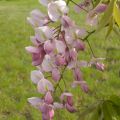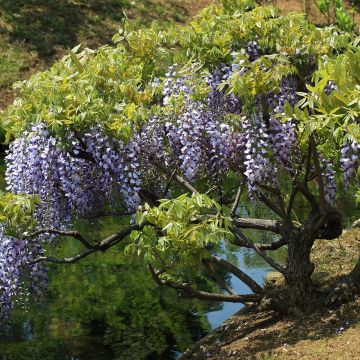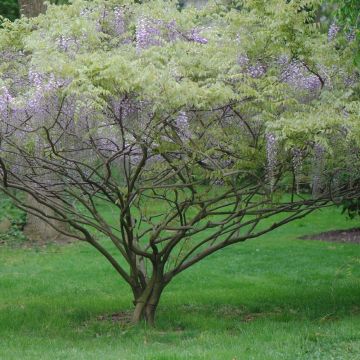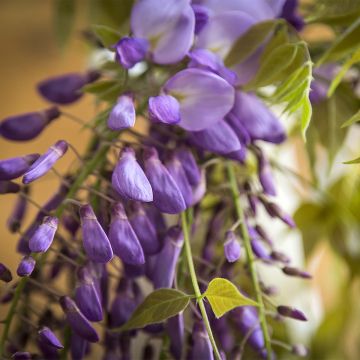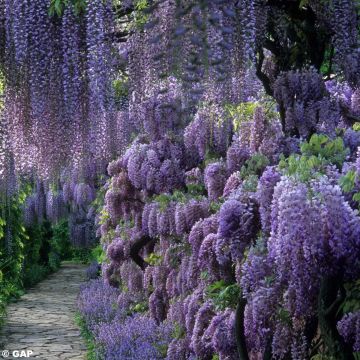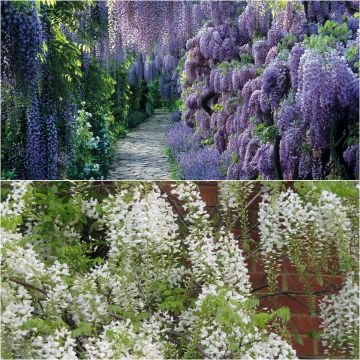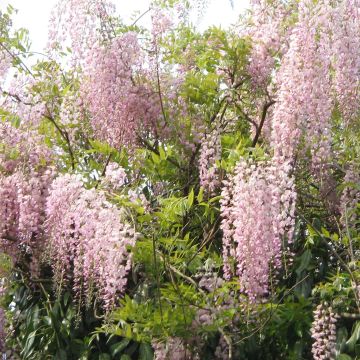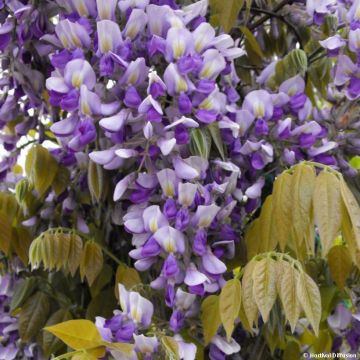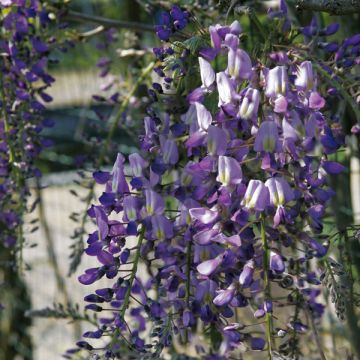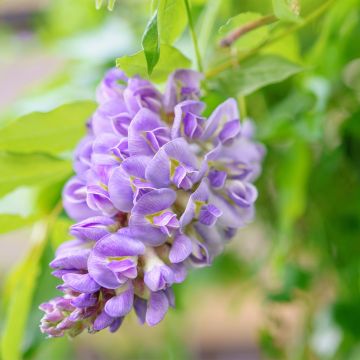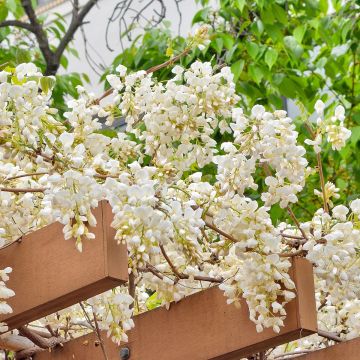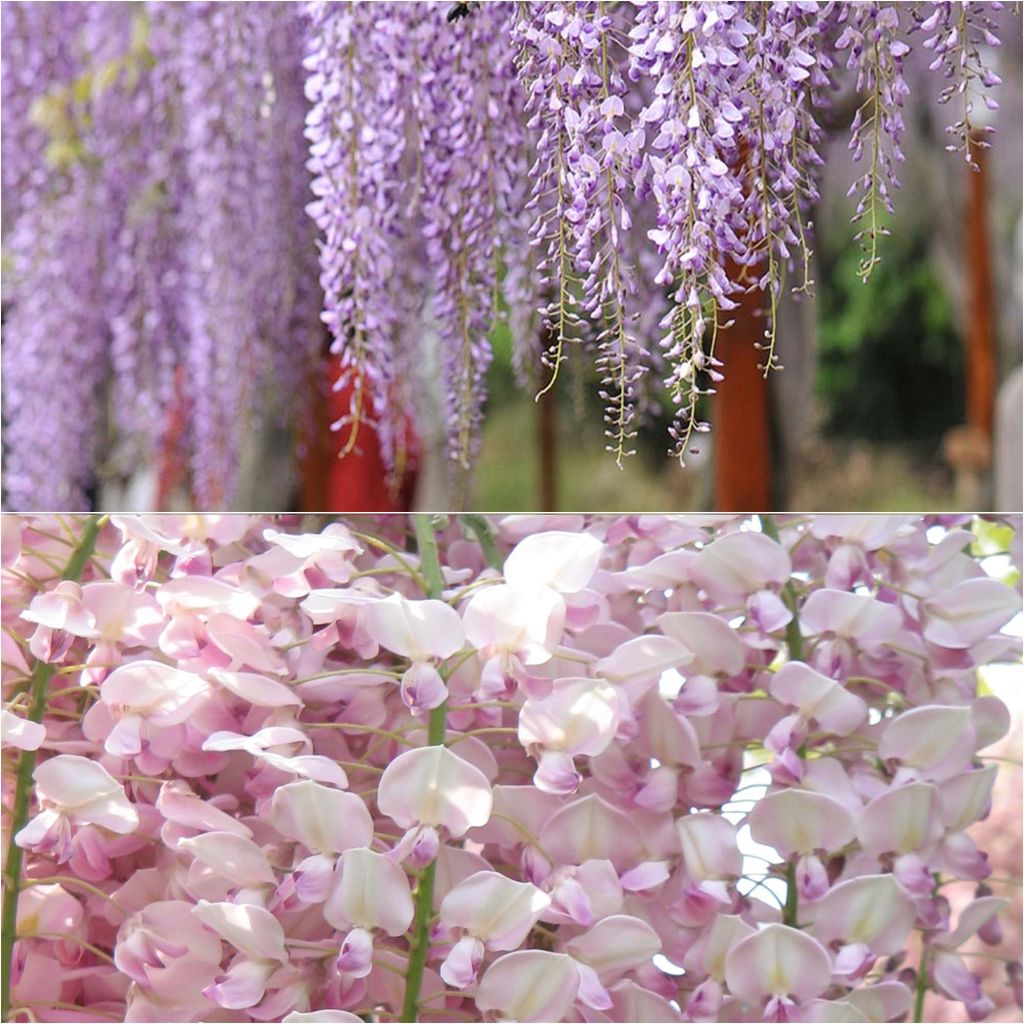

Collection of 2 compact Wisterias
Collection of 2 compact Wisterias
Wisteria venusta Okayama, var. Rosea
This item cannot be shipped to the selected country
Delivery charge from €5.90
More information
Schedule delivery date,
and select date in basket
This plant carries a 6 months recovery warranty
More information
We guarantee the quality of our plants for a full growing cycle, and will replace at our expense any plant that fails to recover under normal climatic and planting conditions.
From €5.90 for pickup delivery and €6.90 for home delivery
Express home delivery from €8.90.
Does this plant fit my garden?
Set up your Plantfit profile →
Collection items (2 plants)
Description
A wonderful duo of Japanese Wisterias, aptly named graceful Wisterias. It brings together two lovely forms of Wisteria venusta, which is less imposing than its cousin, the Chinese Wisteria: the first with pale pink flowers, and the other with mauve-blue flowers. Their shorter clusters, perfectly coordinated in pastel shades, blend together with a delicate floral scent, in spring on barely leafy branches, and sometimes again in late summer, hidden in the foliage. Wisterias spontaneously and eagerly wrap their long twining stems around trellaces, fences, pergolas, and arbours. These are more suitable for small gardens and can also be planted in large containers on the terrace.
This duo consists of a Japanese Pink Wisteria plant (variety Rosea) and an Okayama Wisteria plant.
The Japanese Wisteria, or silky Wisteria, Wisteria venusta (synonym Wisteria brachybotrys) in Latin, is a vigorous climbing plant with rapid growth that won't reach the gigantic size of the Chinese Wisteria. It belongs, like its cousin, to the large family of Fabaceae, along with clover, alfalfa, and lupines. It is native to Japan and China. Its long twining stems, which can reach a length of 5 metres (16 feet), become lignified with age. Sometimes a bit slow to establish, it is a robust plant, perfectly resistant to cold, not very demanding in terms of soil (although it does not tolerate limestone), and capable of growing in poor and dry soils in summer if they are deep.
The stems of the Japanese Wisteria naturally turn clockwise around supports, unlike those of its cousin Wisteria sinensis, which turn counterclockwise. The growth of new shoots is very fast, around 2 to 3 metres (7 to 10 feet) in one season in moist soil. The main flowering occurs in April-May, earlier or later depending on the climate, on fairly young grafted plants. It develops on barely leafy branches located near the lignified main stems. Short, thick, cone-shaped clusters, densely filled with butterfly-like flowers, measuring 20cm (8in) in length, emit a quite pronounced fragrance depending on the varieties, in calm weather. They open from the base to the tip of the cluster. The plant blooms again during late summer, although more timidly. The flowers are followed by pendulous, velvety, flat green pods that turn brown when ripe. The young bronze leaves appear at the same time as the flowering and then turn a light green colour. They are 20 to 35cm (8 to 14in) long and divided into 9 to 11 rounded and slightly velvety leaflets, giving the foliage a lush yet light appearance. Very long-lasting, the silky Wisteria can live for more than 50 years. Its flowering is nectar-rich. The deciduous foliage turns a beautiful yellow colour in autumn before falling.
Wisteria is the epitome of romantic plants. A queen in the kingdom of climbing plants, capable of enhancing a facade or structure, no matter how modest. When two varieties of Wisteria meet and intertwine, the spectacle becomes almost unreal. Particularly useful for covering a wall or hiding an unsightly fence, this duo easily wraps around a fence, porch, or trellis. These two Wisterias may tend to suffocate nearby plants. It is best to plant them in a solitary location, in full sun or partial shade in warm climates. Or, if you have enough space, associate them with vigorous honeysuckles, such as Lonicera x delavayi, which is evergreen and has fragrant yellow summer flowers, or with a Montana Clematis Tetrarose.
However, be patient: the first flowering of the Wisteria may not appear for 2 to 3 years, depending on the growing conditions.
Report an error about the product description
Plant habit
Flowering
Foliage
Botanical data
Wisteria
venusta
Okayama, var. Rosea
Fabaceae
Cultivar or hybrid
Other Wisterias
Planting and care
The Japanese Wisteria venusta is a vine that is easy to grow in many regions, as long as the soil it is planted in is sufficiently deep and preferably non-alkaline. It grows well in any garden soil, with a preference for poor soils. However, it prefers an acidic to neutral soil and may wither in alkaline soil. Once established, it can withstand summer drought and requires no watering. Plant it along a wall or train it on a pergola. Pruning is recommended for better flowering. Plant it in a well-drained soil, trained against a south-facing wall, it will withstand very harsh winters more easily. Wisterias can be trained into tree form by training them on a "parasol" stake of 1.5 to 2m (5 to 7ft), or as a ground cover.
Planting period
Intended location
Care
This item has not been reviewed yet - be the first to leave a review about it.
Haven't found what you were looking for?
Hardiness is the lowest winter temperature a plant can endure without suffering serious damage or even dying. However, hardiness is affected by location (a sheltered area, such as a patio), protection (winter cover) and soil type (hardiness is improved by well-drained soil).

Photo Sharing Terms & Conditions
In order to encourage gardeners to interact and share their experiences, Promesse de fleurs offers various media enabling content to be uploaded onto its Site - in particular via the ‘Photo sharing’ module.
The User agrees to refrain from:
- Posting any content that is illegal, prejudicial, insulting, racist, inciteful to hatred, revisionist, contrary to public decency, that infringes on privacy or on the privacy rights of third parties, in particular the publicity rights of persons and goods, intellectual property rights, or the right to privacy.
- Submitting content on behalf of a third party;
- Impersonate the identity of a third party and/or publish any personal information about a third party;
In general, the User undertakes to refrain from any unethical behaviour.
All Content (in particular text, comments, files, images, photos, videos, creative works, etc.), which may be subject to property or intellectual property rights, image or other private rights, shall remain the property of the User, subject to the limited rights granted by the terms of the licence granted by Promesse de fleurs as stated below. Users are at liberty to publish or not to publish such Content on the Site, notably via the ‘Photo Sharing’ facility, and accept that this Content shall be made public and freely accessible, notably on the Internet.
Users further acknowledge, undertake to have ,and guarantee that they hold all necessary rights and permissions to publish such material on the Site, in particular with regard to the legislation in force pertaining to any privacy, property, intellectual property, image, or contractual rights, or rights of any other nature. By publishing such Content on the Site, Users acknowledge accepting full liability as publishers of the Content within the meaning of the law, and grant Promesse de fleurs, free of charge, an inclusive, worldwide licence for the said Content for the entire duration of its publication, including all reproduction, representation, up/downloading, displaying, performing, transmission, and storage rights.
Users also grant permission for their name to be linked to the Content and accept that this link may not always be made available.
By engaging in posting material, Users consent to their Content becoming automatically accessible on the Internet, in particular on other sites and/or blogs and/or web pages of the Promesse de fleurs site, including in particular social pages and the Promesse de fleurs catalogue.
Users may secure the removal of entrusted content free of charge by issuing a simple request via our contact form.
The flowering period indicated on our website applies to countries and regions located in USDA zone 8 (France, the United Kingdom, Ireland, the Netherlands, etc.)
It will vary according to where you live:
- In zones 9 to 10 (Italy, Spain, Greece, etc.), flowering will occur about 2 to 4 weeks earlier.
- In zones 6 to 7 (Germany, Poland, Slovenia, and lower mountainous regions), flowering will be delayed by 2 to 3 weeks.
- In zone 5 (Central Europe, Scandinavia), blooming will be delayed by 3 to 5 weeks.
In temperate climates, pruning of spring-flowering shrubs (forsythia, spireas, etc.) should be done just after flowering.
Pruning of summer-flowering shrubs (Indian Lilac, Perovskia, etc.) can be done in winter or spring.
In cold regions as well as with frost-sensitive plants, avoid pruning too early when severe frosts may still occur.
The planting period indicated on our website applies to countries and regions located in USDA zone 8 (France, United Kingdom, Ireland, Netherlands).
It will vary according to where you live:
- In Mediterranean zones (Marseille, Madrid, Milan, etc.), autumn and winter are the best planting periods.
- In continental zones (Strasbourg, Munich, Vienna, etc.), delay planting by 2 to 3 weeks in spring and bring it forward by 2 to 4 weeks in autumn.
- In mountainous regions (the Alps, Pyrenees, Carpathians, etc.), it is best to plant in late spring (May-June) or late summer (August-September).
The harvesting period indicated on our website applies to countries and regions in USDA zone 8 (France, England, Ireland, the Netherlands).
In colder areas (Scandinavia, Poland, Austria...) fruit and vegetable harvests are likely to be delayed by 3-4 weeks.
In warmer areas (Italy, Spain, Greece, etc.), harvesting will probably take place earlier, depending on weather conditions.
The sowing periods indicated on our website apply to countries and regions within USDA Zone 8 (France, UK, Ireland, Netherlands).
In colder areas (Scandinavia, Poland, Austria...), delay any outdoor sowing by 3-4 weeks, or sow under glass.
In warmer climes (Italy, Spain, Greece, etc.), bring outdoor sowing forward by a few weeks.

































